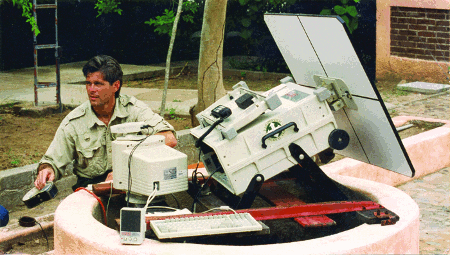Streaming Spotlight: The Many Lives of Jim Bruton
"Ever since I was a child, I was interested in both technology and media," says Jim Bruton. "I would be inspired by Disney's House of the Future while watching wildlife films on television, wondering, "How can I do both?'"
Bruton did go on to do both, and his love of technology and the outdoors-as well as his revolutionary efforts in creating new satellite video systems-have taken him around the world many times, from the depths of the Titanic to the heights of Mt. Everest.
But let's back up a little.
Jim Bruton graduated from the University of North Carolina. Not long after graduating, he was hired to make wildlife films. He worked for National Geographic (where he won an Emmy), CBS, and Anglia Television (now ITV Anglia) in England. But it was while scouting locations for Disney in Namibia in 1992 that his path really began.
"We were out about 300 miles from anyone on the world's tallest sand dunes, and the Disney crew took out a bunch of cases and unfolded a nickelized polyester dish, then pulled out a handset, and called back to their studios. I just thought, ‘This is amazing. We're so remotely located, and they have this instant communication by satellite,'" says Bruton.
Taken with the possibilities, Bruton started to wonder if he could push video over a satellite stream. As a wildlife photographer, he was always thinking of new ways to tell a story, and this seemed like the perfect method. He got his own satellite phone and began testing it out in 1993. He also traveled back to the U.S. to meet with companies such as Bell Labs, Magnavox, and Inmarsat to discuss his ideas. This was during the birth of the World Wide Web, and Bruton presented his ideas to the experts, putting together different pieces of the solution he'd need.
What he needed didn't exist, but he knew he could create it if he could integrate the right ingredients. He started by using an analog video codec from Bell Laboratories, which he had some success with. However, the time it took to push the analog signal up to the satellite and then bounce it back down left a lot of room for errors to creep in. There were so many errors, in fact, that the modems on each end couldn't remain in sync.
Mother of Invention
Moving on, Bruton knew he needed an all-digital path. In 1995, Inmarsat was about to launch a digital service that went commercial after a year of testing. Bruton thought that he could send digital video if he could combine several satellite phones together to create a larger aggregate signal. He was essentially creating his own ISDN network. ISDN channels work in multiples of 64, and while in the Philippines, Bruton figured out how to combine four satellite phones together to create a 256K channel. He successfully tested it and broadcast live for an hour.
 You can only aggregate so many streams, says Bruton-it requires carrying around a lot of satellite phones. He needed to find a practical number of phones that would give him the largest pipe possible. He also needed to find the best video compression. He initially believed that, for such a small pipe, a small camera would perform just as well as a larger one. But he found that even over his satellite stream, viewers really could see a difference. After several field trials, he found his solution.
You can only aggregate so many streams, says Bruton-it requires carrying around a lot of satellite phones. He needed to find a practical number of phones that would give him the largest pipe possible. He also needed to find the best video compression. He initially believed that, for such a small pipe, a small camera would perform just as well as a larger one. But he found that even over his satellite stream, viewers really could see a difference. After several field trials, he found his solution.
"Before you knew it, I had cobbled together a system that worked most of the time," laughs Bruton.
He pulled the wraps off his creation in 1996, when he went live from Mexico during an Earthwatch expedition. His audience was a group of schoolchildren gathered at the Harvard Science Center to learn how animals were tagged and studied. After the demo, Bruton held a live question-and-answer session. It was a breakthrough moment.
"It was fantastic. It really did finally bring together the storytelling aspect and the love of technology aspect," Bruton says. Bruton credits Bob Ballard's work with the Jason Project, a distance education program that showed off the Titanic to schoolchildren, as his inspiration. As Bruton's educational video found an audience, it led to business opportunities that took him around the world, from the jungles of Mexico and Africa to Mt. Everest and even to the Titanic. He began his satellite videos as a feature on the early online service Prodigy, as well as on Apple's eWorld. On Mt. Everest, he showed the huts climbers stayed in, the Sherpas cooking the food, and perilous ice climbing. At the Titanic, he was the field producer for a Discovery Channel expedition and showed a sonar locator that outlined the position of the ship.
The satellite video system that made it all possible was like a TV truck in a suitcase, he says. It let him go to the most remote places on earth and stream live with a portable system. While it wasn't TV-quality footage, it was always compelling. Bruton was able to leverage his credibility as an Emmy award-winning filmmaker for National Geographic to get his foot in the door at companies he wanted to work with. Once he set up his video equipment in those companies' parking lots and gave them live demonstrations of what he could do, they were ready to sign on.Some opportunities surprised him, however, such as the one that took him to the top of Everest.
"The next thing I knew, I was getting a call from [Telekom Malaysia] regarding transmitting live video from Everest for the Malaysian Everest team, on behalf of the king of Malaysia," says Bruton. That was in 1997, and the 5-month project went so well that Bruton went back four more times to shoot video of the annual climb.
Companies and Suppliers Mentioned